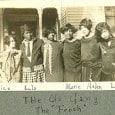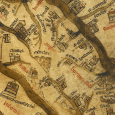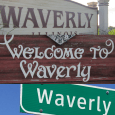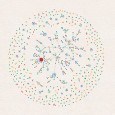-
Recent Posts
Recent Comments
Archives
Categories
Meta
Archives
-
Equity at Iowa
Posted on March 1, 2016 | No CommentsEquity at Iowa The Equity at Iowa project is a collaboration between Judith Pascoe (UI English Professor) and Wendy Robertson (University of Iowa Digital Scholarship Librarian), who are working with Nikki White (Digital Humanities Research and Instruction Librarian) and Ethan DeGross (Researcher/Developer) to explore the open data found in the Iowa State Employee Salary Book. In honor of Women’s History Month, each business day of March 2016, we will be pairing a digital photo from the Iowa Women’s Archive or University Archives with a bar chart or graph that makes visible gender differences in professional status and salary allocation, as well as patterns of change across time. Visit the project site Principal investigator(s): Judith Pascoe Project status: Ongoing Project web link: http://equityatiowa.tumblr.com/ -
Scholarship@Iowa
Posted on January 20, 2016 | No CommentsScholarship@Iowa Scholarship@Iowa showcases scholarship and scholarly resources related to diversity at The University of Iowa. It is our hope that students and faculty interested in diversity and the research in and around these historical underrepresented groups will explore our archives and find themselves and their Scholarship@Iowa. Visit the project site Principal investigator(s): Tom Keegan Project status: Ongoing Project web link: http://dsps.lib.uiowa.edu/atiowa/ -
Remappings
Posted on January 13, 2016 | No CommentsRemappings Geographic Information System (GIS) technologies have revolutionized our ability to grasp how space, place and identity intersect. But while the advances of the digital age have taken us far in mapping accurately socio-historical relationships and patterns, the aesthetics of early mapping—inaccurate yet gorgeous—still carry tremendous visual appeal. Remappings seeks to bridge the gap between old and new mapping processes, and in so doing retell the story of Jewish-Christian interaction in England before the period of resettlement during the late 17th century. For first stage of this project, we are creating an interactive map of England that charts the presence on the island of Jews, who continued to inhabit or visit England long after the 1290 expulsion. This interactive map embraces the aesthetics of such maps as the Gough Map, one of the earliest maps to represent England. Subsequent stages of the project involve creating interactive city maps that feature information about key figures, texts and events associated with urban sites. The story of the Anglo-Jewish presence in England is fraught. The largest massacre of Jews in 12th-century Europe occurred on the island, in the wake of King Richard I’s coronation in London. Waves of rioting throughout England culminated in 1190 in York, where some 150 Jews seeking safety in the city tower committed suicide when it become clear that there was no way to avoid the Christian mob. A century later Edward I commanded an unprecedented expulsion of Jews from England. There is no single best way to memorialize and describe such charged events. Therefore Remappings will provide links to multiple and various artistic, historical and scholarly accounts and interpretations. Remappings seeks to present a balanced account of Jewish-Christian interaction. While some links will concern anti-Jewish aggression and oppression, others will offer information about Jewish agency and independence, and evidence regarding neighborly and genial relationships between Christians and Jews. Remappings also promises to elucidate locations and points of interactions that are typically less visible in traditional written and visual representations of English literary history. Visit the project site Principal investigator(s): Kathy Lavezzo & Lisa Lampert Project status: In development Project web link: https://dsps.lib.uiowa.edu/remappings/ -
Migration is Beautiful
Posted on January 13, 2016 | No CommentsMigration is Beautiful Migration is Beautiful is an initiative of the Iowa Women’s Archives at the University of Iowa Libraries. It speaks to the centrality of migration in understanding and interpreting Iowa history, a history shaped first by Native Americans and later by the migration paths of immigrants from around the world. Despite their significant presence in Iowa, Latina/os have remained invisible in mainstream narratives of Iowa history. This website seeks to illuminate their contributions to Iowa’s economic, social, and cultural history, beginning with the settlement of Mexicans and Mexican Americans in Iowa over a hundred years ago and extending to Puerto Rican Americans and Central Americans. In its title and imagery the Migration is Beautiful website echoes the spirit and work of American artist Favianna Rodriguez. The monarch butterfly is a symbol of migration as a natural occurrence and of the importance of migration to the human experience, connecting us through an intricate web that persists through time and space. Each year, the monarch butterfly begins its journey in the Michoacán region of central Mexico, a key point of departure for many early twentieth century Mexican immigrants to Iowa and the Midwest. Like the monarch butterfly, their migration al norte was often circular and multi-generational. This website is being developed from the Mujeres Latinas Project, which began in 2005 at the Iowa Women’s Archives to collect and preserve primary source materials relating to Latina/o history in Iowa. University of Iowa archivists, librarians, graduate students, and community members conducted over a hundred oral history interviews while many Latino families generously donated their personal letters, memoirs, and photographs along with records of their organizations. As the Mujeres Latinas collections grew, a clearer understanding of Iowa Latina/o history emerged. Today, the collections preserved in the Iowa Women’s Archives provide an important resource used by members of the public, faculty, teachers, and students across many academic disciplines. To make this history accessible to a larger audience, a portion of the original documents from the Mujeres Latinas collection has been digitized for the Migration is Beautiful website. Through life stories, interconnecting themes, and maps, visitors can explore the site in many ways. Migration is Beautiful is a work in progress with additional narratives and documents added as new collections become available for research. Acknowledgements We gratefully acknowledge Favianna Rodriguez for granting permission to use her “Migration is Beautiful” poster for the title and logo of this website. Special thanks to the many families and individuals who have generously donated the rich documents that bring Iowa Latina/o history to light. We especially acknowledge the Iowa councils of the League of United Latin American Citizens and Davenport LULAC Council 10 for their ongoing collaboration and commitment to the work of the Mujeres Latinas project over the past ten years. With their support we can begin to tell a more inclusive narrative of Iowa history. The Mujeres Latinas oral history interviews were conducted between 2005 and 2007 by UI graduate students Teresa García, and Iskra Núñez; educational liaison Georgina Buendía Cruz; UI librarian Rachel Garza Carreón, and the curators of the Iowa Women’s Archives, Kären Mason and Janet Weaver. Janet Weaver and Hannah Scates Kettler developed the Migration is Beautiful website with funding from a Creth technology development grant from the University of Iowa Libraries. Undergraduate students Catherine Babikian and Alysse Burnside and Mariana Ramirez, a graduate student in the UI History Department, contributed much of the website’s content. The website was designed by Creative 512 and produced by the Digital Scholarship and Publishing Studio and the Preservation Department at the University of Iowa Libraries. Visit the project site Principal investigator(s): Janet Weaver Project status: In development Project web link: http://migration.lib.uiowa.edu/ -
Little Magazines
Posted on January 13, 2016 | No CommentsLittle Magazines The Little Magazine Database (LMDB) is an ambitious project that provides a means for collecting, understanding, and exploring the breadth and variety and ultimately the importance of the little magazine in the Sixties. This era has been widely viewed through the lens of social political theory, while literary history has tended to slide over the sixties. The LMDB is conceived in the belief that little magazines were an important literary phenomenon that helped create the counterculture of the 1960s. The first step to understanding their influence is to understand what was in them. Principal investigator(s): Jim Elmborg, Associate Professor, School of Library and Information Science Project status: Completed -
Under the Banner of Waverley
Posted on January 13, 2016 | No CommentsUnder the Banner of Waverley Immensely popular throughout the nineteenth century, the Waverley novels captivated public imagination as enthusiasts drew upon Walter Scott’s fictional histories and settled in new communities. From Virginia to the state of Washington, towns named Waverly appeared between 1830 and 1880—Waverly, Iowa was incorporated in 1859—as settlers established ports, canals, and railroads to access major waterways and undeveloped prairies. Waverly, Nebraska even named streets after Scott’s novels and characters! Clearly inspired by Scott’s ground-breaking novels, these communities provide unique insights into Midwest culture and American identity, particularly during the decades encompassing the Civil War and western migration. Under the Banner of Waverley maps where and when the titular towns were founded, explores why the Waverley novels appealed to American readers, and illustrates how Scott’s legacy continues into the 21st century. Developed by Anne Stapleton (Associate Professor of Instruction, Dept. of English) in collaboration with Studio staff, this project draws upon interactive maps and an array of intriguing images. Visit the project site Principal investigator(s): Anne Stapleton Project status: Ongoing Project web link: http://waverly.lib.uiowa.edu/ -
Program Era Project
Posted on January 13, 2016 | No CommentsProgram Era Project “We need to start documenting this phenomenon, moving out from the illustrious cases of the Iowa Writers’ Workshop and Stanford University to grasp the reality of an enterprise that now numbers some 350 institutional participants and continues to grow. This enterprise is our literary history.” – Mark McGurl, The Program Era: Postwar Fiction and the Rise of Creative Writing The Program Era Project documents the aesthetic and cultural influence of the Iowa Writers’ Workshop by employing data visualization software to track connections between Workshop-affiliated writers and follow their migration into prominent positions at other creative writing programs. Along with these network visualization efforts, Program Era catalogs the history of creative writing at the University of Iowa, tracking trends and demographic shifts as well as employing computer-assisted quantitative analysis methods to compare the styles of Workshop-affiliated writers. The Program Era Project is supported by the efforts of project manager and Digital Humanities & Instruction Librarian, Nikki White, and Ph.D. student in English, Nick Kelly. Visit the project site Principal investigator(s): Loren Glass Project status: In development Project web link: http://dsps.lib.uiowa.edu/programera/blog/ -
Mapping Decline
Posted on January 13, 2016 | No CommentsMapping Decline This web project accompanies the book Mapping Decline: St. Louis and the Fate of the American City (PennPress, 2008). It presents four interactive series of maps, each touching on a major theme developed in the book. After you hit the “go to maps” button, these series will appear as four tabs. Each series is animated by a chronological slidebar, or a menu of map layers. Each series also includes a selection of documents, linked from the maps or the accompanying text boxes. These can also be found on the “documents” page. Further details about the data and images can be found at “about the maps” (both in menu at upper right). Additional interactive maps are available through Harvard Worldmap. Visit the project site Principal investigator(s): Colin Gordon Project status: Completed Project web link: http://mappingdecline.lib.uiowa.edu/ -
Shakeosphere
Posted on January 13, 2016 | No CommentsShakeosphere Facebook and the blogosphere have made us increasingly aware of the power of social networks. But as long as we’ve had societies, we’ve had networks and communication technologies to hold them together. Shakeosphere allows users to visualize, map, and explore these social networks in Shakespeare’s England and beyond, from 1473-1800. Our goal is to make it easy and intuitive to see and search the ways that books, letters, and other documents connected readers, writers, printers, publishers, and booksellers around the globe. Information about early publishers, printers, authors, and the manuscript records they left behind has long been available, but only in far-flung scholarly articles and library catalogues. Shakeosphere brings this data together in one place for the first time. You can create and search visualizations you can create by following the link to “Explore the Data,” then selecting a year or date range. Each “node” on the resulting network map represents a person, and the lines, or “edges” represent the printed or manuscript works connecting the nodes. Users can then curate and query this data to understand the way information travelled in Shakespeare’s world and to learn more about individual authors and texts. In coming updates, we’ll be linking each of these nodes to Wiki pages where users can learn more or upload their own images and text. Visit the project site Principal investigator(s): Blaine Greteman Project status: Completed Project web link: https://shakeosphere.lib.uiowa.edu/ -
Germans in Iowa
Posted on January 13, 2016 | No CommentsGermans in Iowa This online archive was developed to support German Iowa and the Global Midwest, a series of linked events exploring Iowa’s multicultural history through the largest group of European origin to settle in the state. Visit the project site Principal investigator(s): Lisa Heineman & Glenn Ehrstine Project status: Ongoing Project web link: http://germansiniowa.lib.uiowa.edu/










